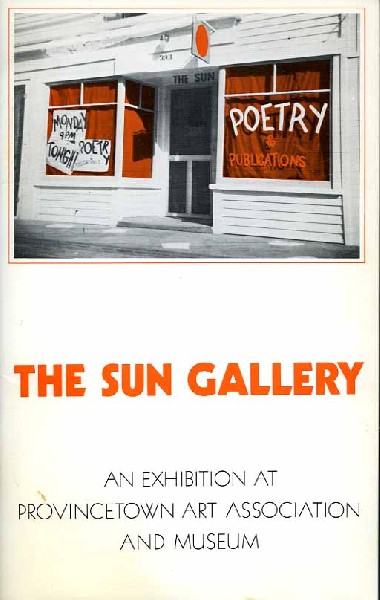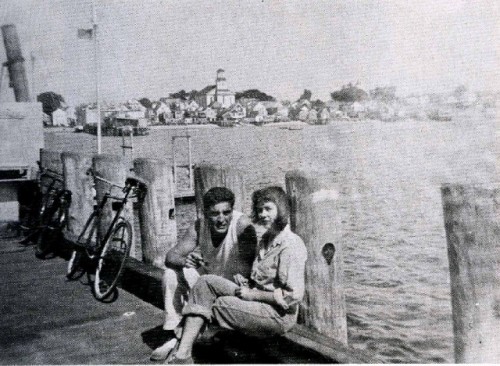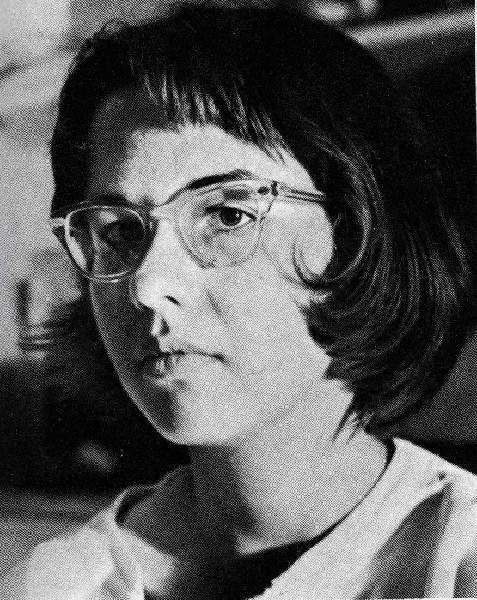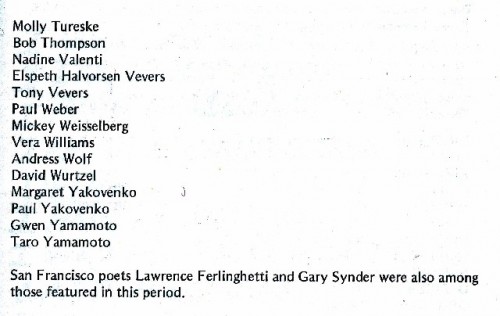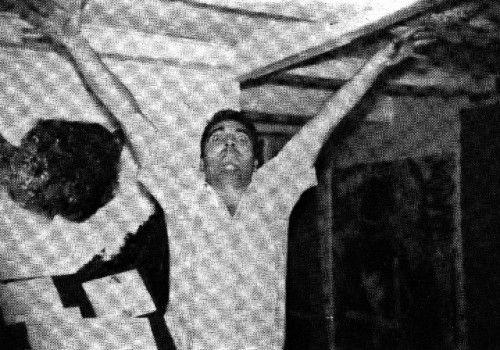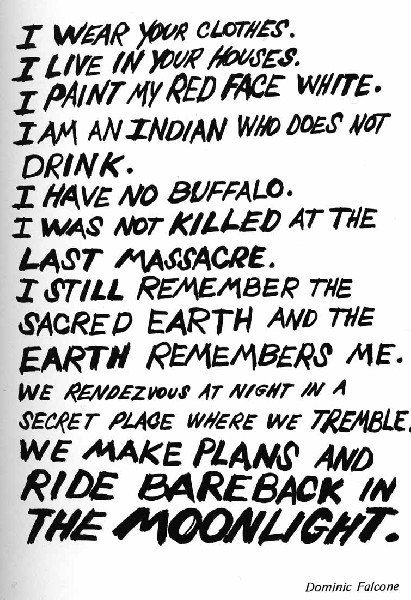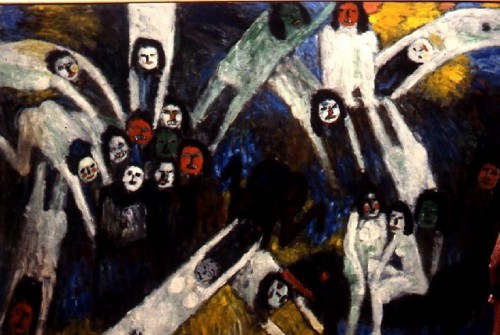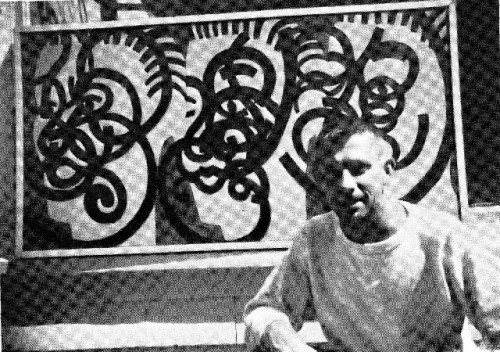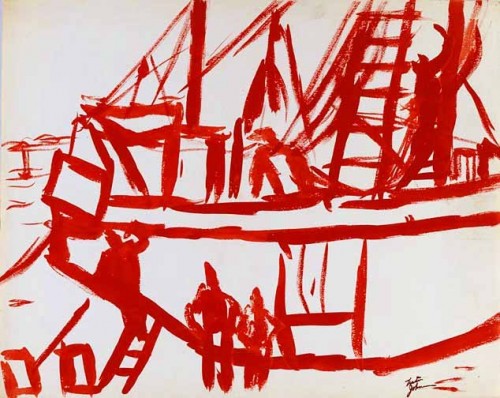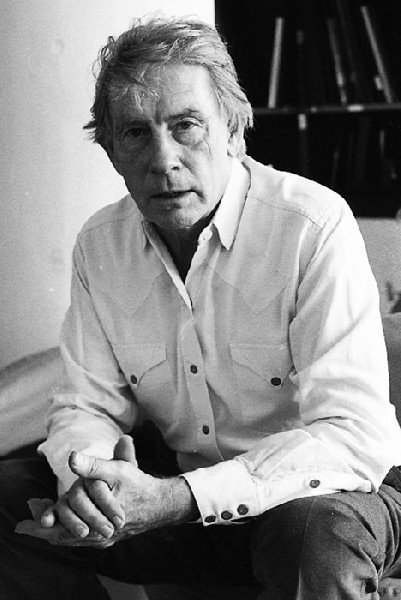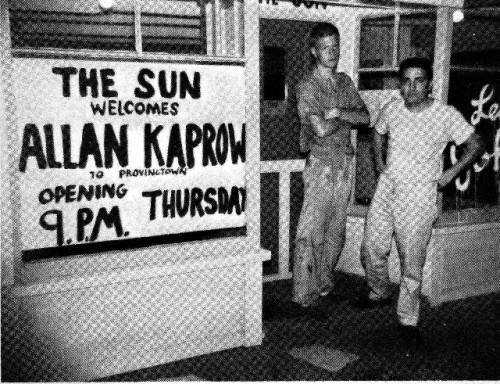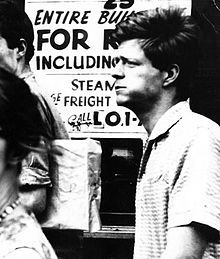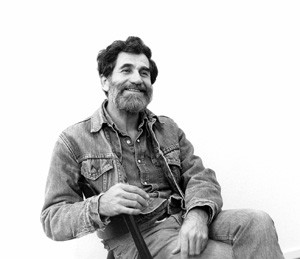Yvonne Andersen on The Sun Gallery
Figurative Expressionism in Provincetown in the 1950s.
By: Yvonne Anderson and Charles Giuliano - May 10, 2013
From 1955 to 1959 the artist Yvonne Anderson and her late husband, the poet Dominic Falcone, operated the legendary Sun Gallery in Provincetown. In one week shows over five seasons, with a combination of group, one man and two man shows they displayed work by about 100 artists. A selection of whom formed the nucleus of the figurative expressionist movement. This summer the Provincetown Art Association and Museum will focus on these artists in Pioneers of Provincetown curated by Adam Zucker.
The Sun Gallery took over a small space that had previously been the gallery and jewelry shop of Earle Pilgrim. In a previous PAAM show I included him in Kind of Blue: Four African American Artists in Provincetown; Benny Andrews, Emilio Cruz, Earle Pilgrim and Bob Thompson.
Anderson documented the exhibitions of the Sun Gallery. With an "$11 camera" she has at least one photograph of each show. Also she shot film of the shows and studios which has been compiled as a DVD.
(These and other Andersen DVDs are available from yellowballworkshop@verizon.net 62 Tarbell Avenue, Lexington, Ma. 02421 for $30 each.plus $5.00 shipping.)
When they left Provincetown the Sun Gallery was operated in the seasons 1960-61 by Irene Baker and Bill Barrell. They added the artists Emilio Cruz, Rosalyn and Sherman Drexler, Claes Oldenburg and film-makers Ken Jacobs and Jack Smith.
From 1962 to 63 the gallery was run by Nat Halper who added Eben Given Jr. (who designed the covers of Boston's publication Avatar), John Frank and George Segal.
No records survive after Andersen and Falcone.
Charles Giuliano Over the years I have written about Lester Johnson, Bob Thompson and Jan Muller among others. This summer I have been invited to write a catalolgue essay for an exhibition curated by Adam Zucker at the Provincetown Art Association and Museum.
Yvonne Andersen Those are our guys. Not so much Bob Thompson. Bob was in a three man show. We had two one man shows for Jan Muller. And five one man shows for Lester Johnson. Did you mention someone else?
CG There are lots of artists I would like to talk to you about. For example where did George Segal come into this?
YA George Segal? He did not show in your gallery as far as I know. I’ve got to look at the list. The name sounds very familiar.
CG He was a Pop art sculptor who did white plaster casts of people.
YA Oh. Here’s the situation. We opened the (Sun) Gallery, my husband and I, Dominic Falcone. It was his idea by the way. He went to work as a dish washer at the Moors Restaurant to pay for it while I ran it. We did this for five years.
We did a lot of what was called innovative things. After awhile I thought we had done everything I could think of to do. We had poetry readings and all kinds of stuff including the first Happening with live actors. So we left. Meanwhile some of the painters who showed in the gallery didn’t want us to leave. So one of them, Bill Barrell, talked to some of the other people we had showed, and they opened the gallery again for a year. We were not there for the last year and it is quite possible that George Segal was in that last listing. (Segal was shown at Sun Gallery when it was run by Irene Baker and Bill Barrell from 1960-1961.)
I have pretty good notes on everybody who was there. Tony Vevers (and Irving Sandler) wrote a catalogue for a Sun Gallery show at PAAM in 1981 (July 24 to August 30). In that catalogue he mentions a few of the people who showed after we were gone. I think that’s where he is if you want me to confirm that.
CG What were people thinking, including yourself, about the figure? Of course people came to Provincetown to study with Hans Hofmann.
YA Me included.
CG But people were pulling away from that. Artists like Red Grooms and Lester Johnson. Jan Muller was European. Artists were talking about a return to the figure. Do you recall people talking about that?
YA Yes. Hmm. Let’s see. I’ll tell you what happened to me. Actually, if you want me to send it to you, I have a video on the Sun Gallery. We became filmmakers after we left the Sun Gallery. We ran a film series and I showed a lot of these people who I shot with documentary footage. Tony Vevers, Alex Katz.
As to this particular question I can tell you about the years we were in Provincetown. Val was interested in art. He was a poet. But I remember him not being very comfortable about modern art. For myself both abstract and modern were fine. I went to L.S.U. on a band scholarship. But quit the music department and moved over to fine arts. My instructor was Peter Kahn. He was the brother of Wolf Kahn. Both of those guys were students and teaching assistants of Hans Hofmann.
Peter Kahn by the way was a great teacher. Probably the best teacher I ever had. I asked him where he studied and he said, “Well I studied with Hans Hofmann.” So I said “Well I guess I’ll go study with Hans Hofmann.” I was over at his house at the time because he had invited me for a Sunday dinner. A number of times. His younger brother Wolf Kahn was there. He said “You know if you want to go study with Hans Hofmann I can find you a place to live there.”
He got me a place at Sunny Tasha's house. A lot of artists lived there. Alan Kaprow lived about ten yards from my spot. She made all these little houses and constructions in her back yard. Throughout her house. John Grillo also lived there.
My roommate and I went to Provincetown. We studied with Hans Hofmann. My roommate was Betty King who lives in Brazil. She’s also an artist. She’s shown at some big museums there. Her work is mostly abstract. She works a lot in anodized aluminum. She was just there that one summer but you can see her in the video.
When we started the gallery my husband had a certain vision about it. We wanted to concentrate on showing new people. Young people who we thought were very interesting. I guess we sortah got a reputation for picking out good new people.
Everyone was welcome to show at the Sun Gallery. Anyone who came by and asked to show I showed. We had group shows, one man shows, two man shows. We had a five man show once. So everyone could participate.
It was different in those days. If we wanted to have a program that night we put a poster in the window. Maybe a day before and everyone would come.
CG It was a very small space.
YA A very small space. We had a new show every week. On Sunday night we took down the old show and put up orange curtains. We would hang the new show and on Monday night there would be a big crowd of people across the street at nine o’clock when we opened up and they would all come in. One time it was so instantly crowded that I had gone outside and couldn’t get back in.
It was always controversial. People would come by to see what was our latest outrage.
CG Coming back to the question, what about the figure?
YA The figure? I myself was a Hans Hofmann student. He seemed to like everything I did which was fairly abstract. Maybe semi figurative. I was there for awhile with him and nothing seemed to be happening. I realized why he didn’t work for me was I had already learned it from his student. I learned all of that stuff.
I don’t know we just seemed to be going in that direction. My husband was certainly not interested in abstract art. He was very much an expressionist. He gave a number of readings when we were having our gallery.
There was a lot of talk about this going on all the time. I didn’t participate in intellectual discussions. A lot. Myself. I was a very practical person. I was the one that got everything done. Got it hung and got the people to come. Of course it was a place for me to show my work. Which was kind of a cross between the two (abstract and figurative). My husband got to give readings and show his poems and art.
It just sort of grew. We arrived in Provincetown. We put a sign in the window.
CG Is it just a coincidence that the artists you showed were figurative? Is it just that these were the artists who were around?
YA We gave one man shows to the artists we liked.
CG What was it that you liked?
YA We liked a strong expression of emotion. Which was pretty visible in the human figure.
CG Now that art historians are interested in figurative expressionism the Sun Gallery had become a center for all that. The monument.
YA Yes we were. People seemed to think that new stuff was happening. After the first two years a lot of people wanted to show at the gallery.
Jan Muller had a one man show at the Hansa Gallery in New York. Then he had a one man show at the Sun Gallery. It made such a strong statement that the next year he got a show. I think it was at the Whitney. People we were showing started catching on in New York.
(There was a strong Provincetown connection to Hansa Gallery, 1952-1959. 70 East 12th Street - Fall 1952 - Fall 1954. 210 Central Park South, Fall 1954 - Summer 1959. (* denotes original members). Edward Avedisian, Maurice Barr, *Jacques Beckwith, Robert Beauchamp, Lilly Brody, *Jean Follett, * Barbara Forst, *Miles Forst, Hedi Fuchs, Paul Georges, *John Gruen, Dan Haugard, *Wolf Kahn, *Allan Kaprow, Fay Lansner, Andrew Martin, Dody Muller, *Jan Müller, *Felix Pasillis, George Segal, * Arnold Singer, * Richard Stankiewicz, Myron Stout, Robert Whitman, *Jane Wilson. Directors of the Hansa Gallery were Richard Bellamy and Ivan Karp.)
So everyone wanted to show at our gallery.
CG Would you say that the most important artist was Jan Muller?
YA No. I hate to say that he was the most important artist but we had five artists we liked quite a bit. We liked Jan. We showed him and then he was dead. (December 27, 1922 – January 29, 1958) I can still remember when his friends brought over this huge painting. They carried it over from his house. It went across the whole back of the gallery. A monster painting. I think it was called “Of This Time Of That Place.”
We liked Lester Johnson (January 27, 1919 – May 30, 2010).
Then my husband was washing dishes at The Moors. The Fourth of July came and they hired his young kid from Nashville, Tennessee. My husband stayed late to help him survive. Then he found out he was a painter. He asked me to come over and look at his drawings. I was flabbergasted. To tell you the truth. So we started having Red Grooms (born Charles Rogers Grooms on June 7, 1937) in many of our shows.
We finally gave him a one man show and that show I remember being very criticized. People were saying “Why are you showing a 21-year-old guy?” From Nashville. You should be showing more established people. But we all know what happened with that.
CG You said that you liked five artists. So far; Jan Muller, Lester Johnson, Red Grooms.
YA Tony Vevers was one.
CG That’s four.
YA Let’s see. Joan Wye. She was married to Jim Fosberg. I worked in his Studio Shop in Provincetown in the mornings. He was the manager of the shop. He had a two man show at the gallery.
CG What was Alan Kaprow doing?
YA When I met him I had just moved to Provincetown. My roommate and I were living in a basement apartment. Of Sunny Tasha's facing out to a back she had a space that was kind of like a garage and Alan Kaprow was living in that. He was a friend of Wolf Kahn. John Grillo lived upstairs. There was a community garden we all worked in. If you pulled the weeds you could eat the food.
We were friends with him (Kaprow) and it was very interesting a few years later. I was finishing school at L.S.U. with one more course to take. I wasn’t going to be in Baton Rouge. They said, we know you’re going to Provincetown. If there are any college professors there they can give you your test. That’s what Alan Kaprow did for me.
CG Was he painting?
YA Yes he was painting.
CG Do you remember what the paintings looked like?
YA No. I was going to the Hofmann school. My roommate and I were working. We had no money. We used to go get free fish from the fishermen. In the morning. We saw Alan and were in his place a lot. But I don’t remember exactly what he was doing.
CG Do you remember his performance in Provincetown?
YA The first showing of Alan Kaprow that I saw was in New York City in the Hansa Gallery when he had something that he called Happening. This Happening didn’t have any actors in it. My husband Val, Red and I were sharing a loft in New York. We went to the Hansa show. They had music playing. They had this big thing called a "Veronica." Like a big piece of cloth. Cut up things were sewed to it. There were sort of artworks with things moving. From a breeze from a fan I think. Music was playing. That I believe is considered the first Happening.
CG Did he do a Happening at Sun Gallery?
YA That was by Red Grooms. It had live actors.
CG So Alan Kaprow did not do a Happening in Provincetown.
YA No. he did show at our gallery, later.
CG What did he show?
YA Well he showed the "Veronica" for one thing. We had him come pretty much right after his (Hansa) show. I think in the spring he had the "Veronica" shown at the Hansa Gallery that summer we showed it at our gallery along with some other stuff. (Veronica Collage and paint on canvas, 1956 145 x 120 cm). I have at least one photograph of each of our shows. I had an eleven dollar camera at the time.
We do have a picture of Red and Val (Falcone) standing outside the gallery. I think we have a sign saying “Welcome to Alan Kaprow.”
CG What did Claes Oldenburg show.
YA That was after us and Bill Barrell set that up. He was very connected to Tony Vevers. One of their shows was visited by the police as was one of ours. It was a Vevers show and he had a great painting of himself. Nude with a wolf like thing on his back. We didn’t put it so people passing by could see it. This was the ‘50s. We put it on a side wall. People managed to see it anyway. Also they were upset about one of my husband’s poems. That’s when the police came. They tried to get our landlady to close us down but she refused.
CG How much rent did you pay?
YA $500 for the whole summer.
CG Was that a lot of money?
YA It was for us. I was working part time in the morning at the Studio Shop and my husband was working full time.
CG I imagine you didn’t make any sales.
YA Oh yes we did occasionally. But that wasn’t our main interest. We treated the whole thing as a form of theatre. One night we came back to the gallery after it was closed. There was this man with his nose pressed against the glass. He was smoking a cigar. My husband walked up to him and asked if he would like to go in. It was the Tony Vevers show. We went in the gallery and he bought a painting. Tony had done a really terrific big painting called “The Funeral.” It was Jan Muller’s funeral. I didn’t know who Hirshhorn was. The next day a painter came by and I said “This guy, Hirshhorn, said he was going to give us a check. Do you think it will be good?”
Hirshhorn, by the way, did not give us that check immediately. We shipped the painting. It was part way into the summer and Tony said “What happened?” I sent a letter to Hirshhorn. Three days after he left Provincetown he was on an airplane that crashed. He was a hero who saved a lot of people. He said his memory was completely wiped out. He forgot that he had to send us a check for $400.
CG Did Walter Chrysler buy anything from you?
YA No. He tried to buy things through the artists but not through us. He was trying to save money.
CG He was famous for that.
YA It wasn’t our main interest. For Jan Muller we sold a couple of his small pieces to a guy who had quite a bit of money. We gave Jan the money. They were very inexpensive for which we didn’t take any fee. Our fee then was 20%. Which was lower than galleries which was about 30%. Then this guy gave us back the paintings and wanted his money back. We said “We already paid him.” That was the end of that.
CG Did you acquire any paintings? Did you collect?
YA We had a lot of paintings. In 1981 PAAM did a Sun Gallery show. Then they did another one in 2003. We took a lot of stuff down there. We have works by Red Grooms, Lester Johnson, Alex Katz, Tony Vevers. I did have one small Jan Muller. A very nice painting that he gave me. A couple of years after we left Provincetown we were trying to build a house here in Lexington. The contractor ran into rocks and would have to use explosives to build our bathroom. Nat Halper who ran HCE gallery at the other end of town had been trying to buy that Jan Muller painting from me. It had been up for sale in my gallery for $100. He offered me a thousand and I took it. I figured Jan would want us to have a bathroom.

